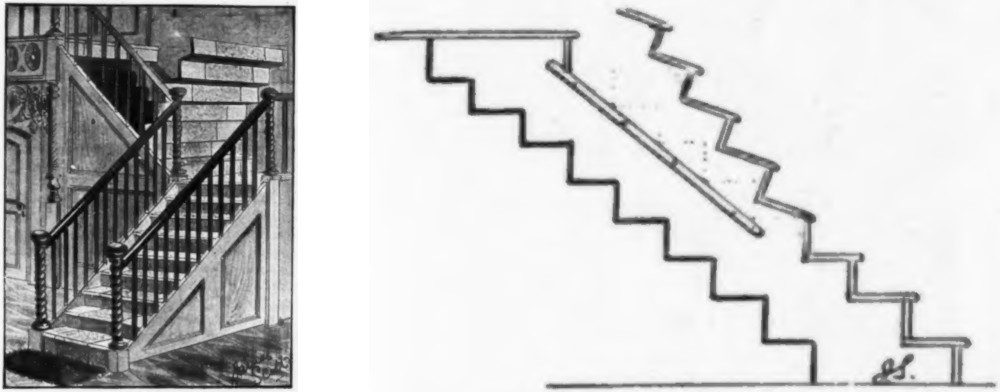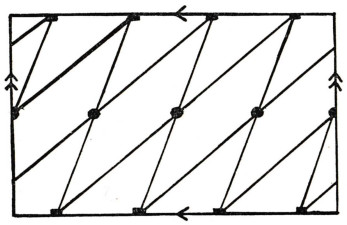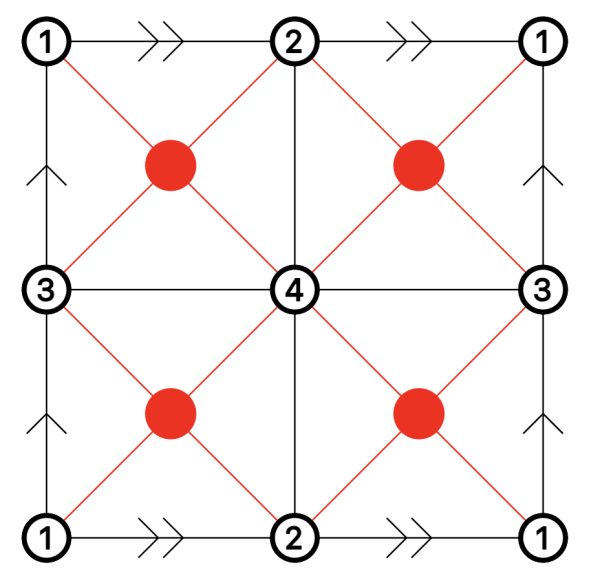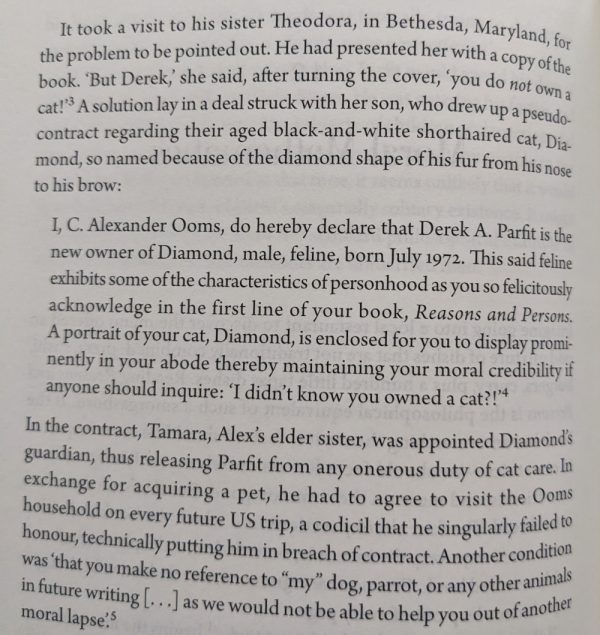A puzzle by Soviet science writer Yakov Perelman: Six carpenters and a cabinetmaker were hired to do a job. Each carpenter was paid 20 rubles, and the cabinetmaker was paid 3 rubles more than the average wage of the whole group. How much did the cabinetmaker make?
Author: Greg Ross
Unquote
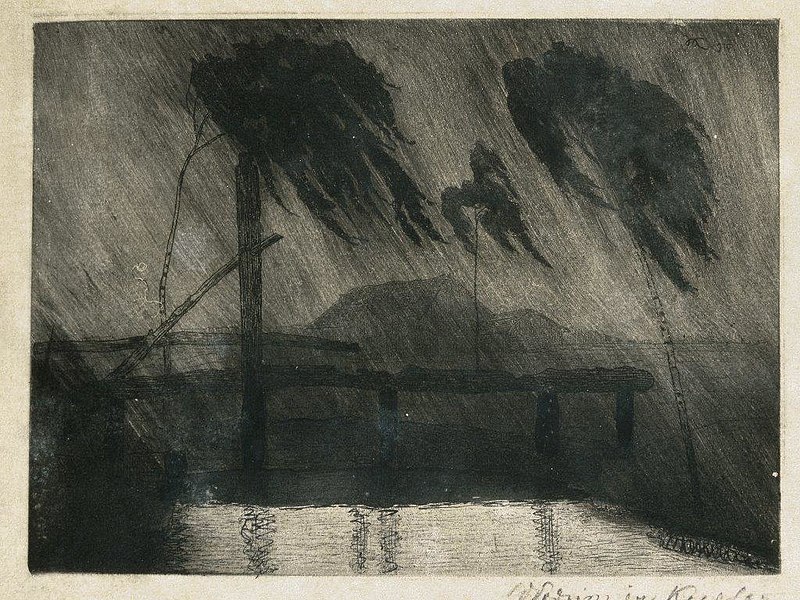
“This thing called rain can make the days seem short and the nights seem long.” — Chang Ch’ao
Flight
In an article on secret hiding places in the Strand, December 1894, James Scott describes an ingenious refuge in the space between two matched flights of stairs. The functional set of risers on top can be raised to reveal a false set below, and the fugitive can take his place in the space between the two. When the door is closed again, searchers see only an ordinary staircase, and if they examine the empty cupboard beneath they’ll see only the apparent undersides of the risers above, which match them in number and size. There’s no perspective from which they can view the purported single stair from both above and below, and thus no reason to imagine that it might be double.
“Tapping upon what they believed to be the underside of the proper stairs would produce a hollow sound; but as a similar response must be expected when legitimate stairs are tapped, that point would not be considered a valuable clue,” Scott writes. “The quarters would be truly uncomfortable, as the necessities of the position would demand that the prisoner should lie at full length in the cavity. Perhaps, however, some provision was made whereby slight relief was afforded.”
Authority

“King James said to the fly, Have I three kingdoms, and thou must needs fly into my eye?” — John Selden
“The autocrat of Russia possesses more power than any other man in the earth, but he cannot stop a sneeze.” — Mark Twain
Mass Transit
A problem from the October 1964 issue of Eureka, the journal of the Cambridge University Mathematical Society:
The planet Kophikkup is in the shape of a torus or ring-doughnut. There is a direct mono-rail line from each of the four space-ports to each of the major cities. No lines join or cross. What is the greatest possible number of major cities? Draw a diagram for this case.
Anagram
Corresponding with Leibniz about his method of infinite series in 1677, Isaac Newton wanted to advert to his “fluxional method,” the calculus, without actually revealing it. So he used an unusual expedient — after describing his methods of tangents and handling maxima and minima, he added:
The foundations of these operations is evident enough, in fact; but because I cannot proceed with the explanation of it now, I have preferred to conceal it thus: 6accdae13eff7i3l9n4o4qrr4s8t12ux. On this foundation I have also tried to simplify the theories which concern the squaring of curves, and I have arrived at certain general Theorems.
That peculiar string is an inventory of the letters in the phrase that Newton wanted to conceal, Data aequatione quotcunque fluentes quantitates involvente, fluxiones invenire; et vice versa, which means “Given an equation involving any number of fluent quantities to find the fluxions, and vice versa.” So “6a” indicates that the Latin phrase contains six instances of the letter A, “cc” means that there are two Cs, and so on. In this way Newton could register his discovery without actually revealing it — the fact that he could present an accurate letter inventory of the fundamental theorem of the calculus proved that he’d established the theorem by that date. (More details here.)
Robert Hooke had used the same resource in 1660 to establish priority for his eponymous law before he was ready to publish it. And Galileo first published his discovery of the phases of Venus as an anagram. The technique today is known as trusted timestamping.
(Thanks, Andy.)
Bequest
“Knight, With Umbrella”
The difficulty with all
Forms of heroism
Is that they require
Appropriate occasions,
And that these are rarer
Even than heroes.
Counsequently, the hero
Waits and waits,
Exquisitely aware
Of the absence of any
Heroic way
To mail a letter,
Buy theatre tickets,
Or put on rubbers.
Most remarkable about
The older heroes
Is their luck in encountering
Punctual dragons,
Compliantly belligerent,
And maidens regularly
Requiring rescue.
I observe all this
A little bitterly,
Shivering
In rented armor
On an icy corner,
Late for the costume
Party, and reflecting
How long one waits,
These days,
Even for a cab.
— Elder Olson
Moonlighting
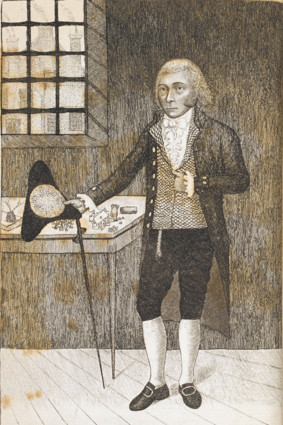
In 1788, when two thieves were arrested for robbing an Edinburgh excise office, they identified a surprising accomplice — William Brodie, a respected city councilor and president of a local trade guild.
Brodie had been leading a double life, using his day job as a cabinetmaker and locksmith to learn about residents’ security practices and to make copies of their keys, then becoming a housebreaker by night, robbing the same customers.
It appears he’d kept this up for 20 years. He was using the proceeds of the burglaries to fund a gambling career and to support five children he’d had by two different mistresses.
After the discovery he fled, but the authorities caught up to him in Amsterdam as he prepared to leave for America.
He was hanged before a crowd of 40,000 people, and his double identity helped inspire Robert Louis Stevenson to write Strange Case of Dr Jekyll and Mr Hyde.
Cause and Effect
When we are praying about the result, say, of a battle or a medical consultation, the thought will often cross our minds that (if only we knew it) the event is already decided one way or the other. I believe this to be no good reason for ceasing our prayers. The event certainly has been decided — in a sense it was decided ‘before all worlds.’ But one of the things taken into account in deciding it, and therefore one of the things that really causes it to happen, may be this very prayer that we are now offering. Thus, shocking as it may sound, I conclude that we can at noon become part causes of an event occurring at ten a.m.
— C.S. Lewis, Miracles, 1947
Lewis adds, “Some scientists would find this easier than popular thought does.” In his 2016 book Time Machine Tales, physicist Paul J. Nahin writes, “It is a view that does find much support in the block universe interpretation of Minkowskian spacetime. Lewis never mentions the block concept by name, but it is clear that he believed in the idea of God being able to see all of reality at once.” See Asking Back.

